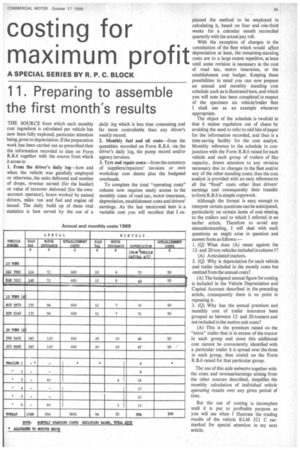11. Preparing to assemble the first month's results
Page 61

If you've noticed an error in this article please click here to report it so we can fix it.
THE SOURCE from which each monthly cost ingredient is calculated per vehicle has now been fully explored, particular attention being given to depreciation. If the preparation work has been carried out as prescribed then the information recorded to date on Form R.B.6 together with the source from which it arose is: 1. From the driver's daily log—how and when the vehicle was gainfully employed or otherwise, the units delivered and number of drops, revenue earned (for the haulier) or value of turnover delivered (for the ownaccount operator), hours worked by named drivers, miles run and fuel and engine oil issued. The daily build up of these vital statistics is best served by the use of a
daily log which is less time consuming and far more controllable than any driver's weekly record.
2. Monthly fuel and oil costs—from the quantities recorded on Form R.B.6. via the driver's daily log, the pump record and/or agency invoices.
3. Tyre and repair costs—from the summary of suppliers/repairers' invoices or own workshop cost sheets plus the budgeted overheads.
To complete the total "operating costs" column now requires ready access to the monthly costs of road tax, motor insurance, depreciation, establishment costs and drivers" earnings. As the last mentioned item is a variable cost you will recollect that I ex
plained the method to be employed in calculating it, based on four and one-third weeks for a calendar month reconciled quarterly with the actual pay roll.
With the exception of changes in the constitution of the fleet which would affectdepreciation at least, the remaining standing costs are to a large extent repetitive, at least until some revision is necessary in the cost of road tax, motor insurance, or the establishment cost budget. Keeping these possibilities in mind you can now prepare an annual and monthly standing cost schedule such as is illustrated here, and which you will note has been completed in respect of the specimen six vehicle/trailer fleet I shall use as an example whenever appropriate.
The object of the schedule is twofold in that it makes regulation out of chaos by avoiding the need to refer to odd bits of paper for the information recorded, and thus is a time-saving facility for the cost analyst. Monthly reference to the schedule in conjunction with the Form R.B.6 raised for each vehicle and each group of trailers of like capacity, draws attention to any revision necessary due to changes in the fleet and/or any of the other standing costs: thus the cost analyst is provided with an easy reference to all the "fixed" costs other than drivers' earnings and consequently their transfer to form R.B.6 is simple copywork.
Although the format is easy enough to interpret certain questions can be anticipated, particularly on certain items of cost relating to the trailers and to which I referred in an earlier article. Therefore to avoid any misunderstanding, I will deal with such questions as might arise in question and answer form as follows: 1. (Q) What does (A) mean against the 12and 20-ton vehicles included in column 1? (A) Articulated tractors.
2. (Q) Why is depreciation for each vehicle and trailer included in the montly costs but omitted from the annual costs?
(A) The budgeted annual figure for costing is included in the Vehicle Depreciation and Capital Account described in the preceding article, consequently there is no point in repeating it.
3. (Q) Why has the annual premium and monthly cost of trailer insurance been grouped as between 12and 20-tonners and not included in the motive unit costs?
(A) This is the premium raised on the "extra" trailer that is in excess of the tractor in each group and since this additional cost cannot be conveniently identified with a particular trailer it is spread over the three in each group, then costed on the Form R.B.6 raised for that particular group.
The use of this aide memoire together with the costs and revenue/earnings arising from the other sources described, simplifies the monthly calculation of individual vehicle operating results over any given period of time.
But the use of costing is incomplete until it is put to profitable purpose as you will see when I illustrate the trading results of the vehicle KLM 321 C earmarked for special attention in my next article.




























































































































